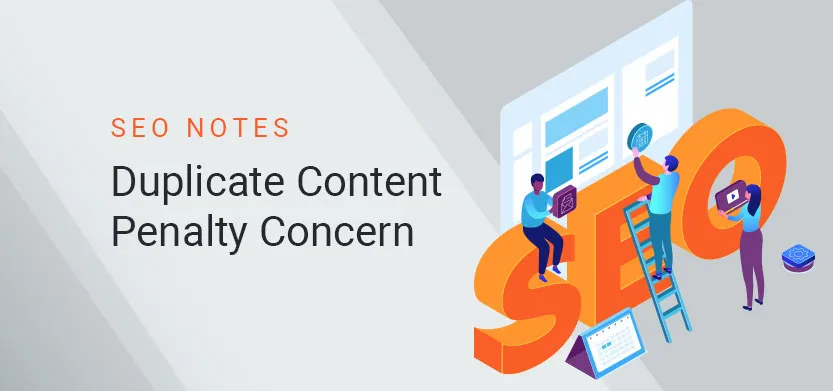
Posted in Digital Commerce
February 16, 2022
SEO notes — Duplicate content penalty concern
Recently, one of our developers Mike Dupree had some SEO-related questions from a client. The main concern was around duplicate content penalties and how to overcome them with a multi-site ecommerce setup. These are my notes and findings from that investigation.
What are the SEO implications for duplicate content?
Listen to this post by using the player, or subscribe using Spotify, Apple Podcasts, or Google Podcasts.
Is there an SEO penalty for duplicate content?
Mike Dupree:
So, I'm currently working with a client on a new build. He has two ecommerce sites that we will be rebuilding with Drupal.
The sites are going to stay as two sites with one backend that shares some products (not all). He has concerns about duplicate content. Being that this is a single backend, without some serious custom work done, we are unable to change the product details per domain, IE if product A is shown on both sites they will have exactly the same title, description, etc.
I’m wondering how that's going to affect his current SEO rankings. Is only one site going to be indexed? Will one rank higher than the other but both still show in search results?
I’m not too familiar with how SEO handles these sorts of things, and want to make sure I have a solid plan in place as to not hurt their current SEO standings as right now they duplicate products and change the data for each site in order to achieve unique content for the products that appear on both sites.
Investigation findings
As long as duplicate content does not have malicious intent (plagiarism, keyword stuffing, etc.) Google does not have a direct duplicate content penalty or policy.
In the case of this client, the two sites could still potentially rank for the same product, but if the content on the product page is exactly the same as other sellers, the product pages could lose ranking.
Search engines rank based on more than just the content. They realize that 25% to 30% of content on the internet is duplicate, and that is ok. The key is to differentiate as much as possible and publish product pages that provide value.
My concerns would be less about the SEO rankings and more about the user experience in this particular use case.
Each site should be tailored to optimize the user experience and use SEO best practices.
Direct answers
I’m wondering how that's going to affect his current SEO rankings.
There is no direct penalty for duplicate content, so the site should not lose ranking as long as all other SEO variables remain the same. The key here is to continually look for ways to improve each site’s SEO individually.
Is only one site going to be indexed?
As long as both sites are marked for indexing, they should both be crawled by search engine bots. NOTE: the client may want to submit an updated sitemap to Google, but keep in mind Google also re-crawls pages on its own, and it's ok to let this process work in the background as content is created or updated.
Will one rank higher than the other but both still show in search results?
Yes, if the content is identical, Google will rank one higher than the other and may drop the youngest one. See my suggested solution below and optimization tips.
Suggested solution
Right now they duplicate products and change the data for each site in order to achieve unique content for the products that appear on both sites.
In my opinion, this is the best route to continue with. It keeps the content unique and should not have a detrimental impact on search engine rankings. That said, there may be a way to make the process easier for the client by looking at the amount of content they change. It doesn’t have to change much to be considered “unique”.
Clone shared products
Clone each one in the backend for the shared products and assign one copy to each site. Then, spend a short amount of time altering/updating the product descriptions for each, and updating the page title and meta information for each.
Tips for optimization
Include an internal link to another non-duplicate product or content page on each product. Those internal links will improve the authority of the duplicate content.
Product descriptions do not have to be complete re-writes. Changing as little as one bullet point in a product feature list will make the content unique to a bot crawling the page. (Pro tip: Change the first bullet point in the list to make it easier.)
When setting page titles and URLs, keep them as clean as possible. ”URL parameters, such as click tracking and some analytics code, can cause duplicate content issues. This can be a problem caused not only by the parameters themselves but also the order in which those parameters appear in the URL itself.”
Make sure to set unique alt tags for the images associated with the product.
Example:
- Site A image alt tag: Sunbeam Coffee Maker | Site A
- Site B image alt tag: Site B | Sunbeam Coffee Maker
If the client is using categories for their products, make sure that the content is different for each category level page. Once again, they don’t need to be drastically different but do need to have some differentiation.
Once again though, Google does not have an express penalty for duplicate content. So, if there are too many products that are shared between the two sites to make cloning an option, my alternate suggestion is to run them both and monitor the results. The client may find that after three months of traffic there is no discernible difference in search engine rankings.
The only item I would add to that suggestion is when the client is looking at the results three to six months after the initial launch, to look at them from a high-level position: Overall site ranking, category page ranking, etc. rather than a micro-view per product.
Conclusion (aka TL;DR)
- Google does not have a direct duplicate content penalty or policy, but don’t plagiarize or keyword stuff. Malicious intent will affect your ranking.
- Optimize shared product pages to make them unique as possible without major effort.
- Include an internal link to another non-duplicate product or content page.
- Changing as little as one bullet point in a product feature list will make the content unique.
- Set unique alt tags for the images associated with the product.
- If using categories, make sure that the content is different for each category level page.


